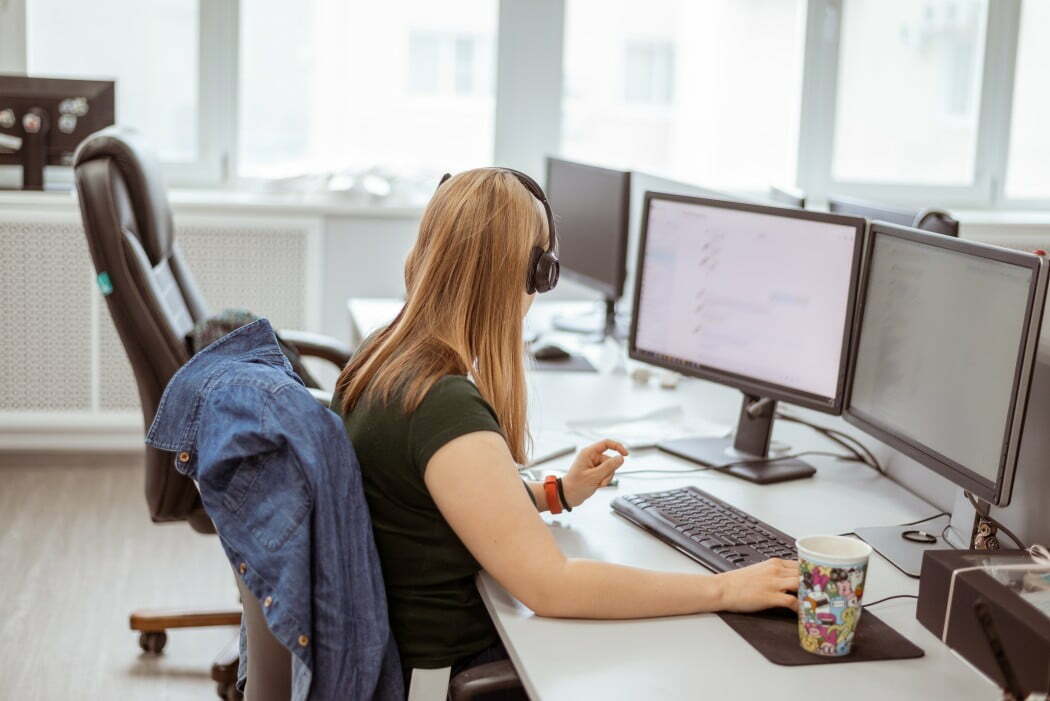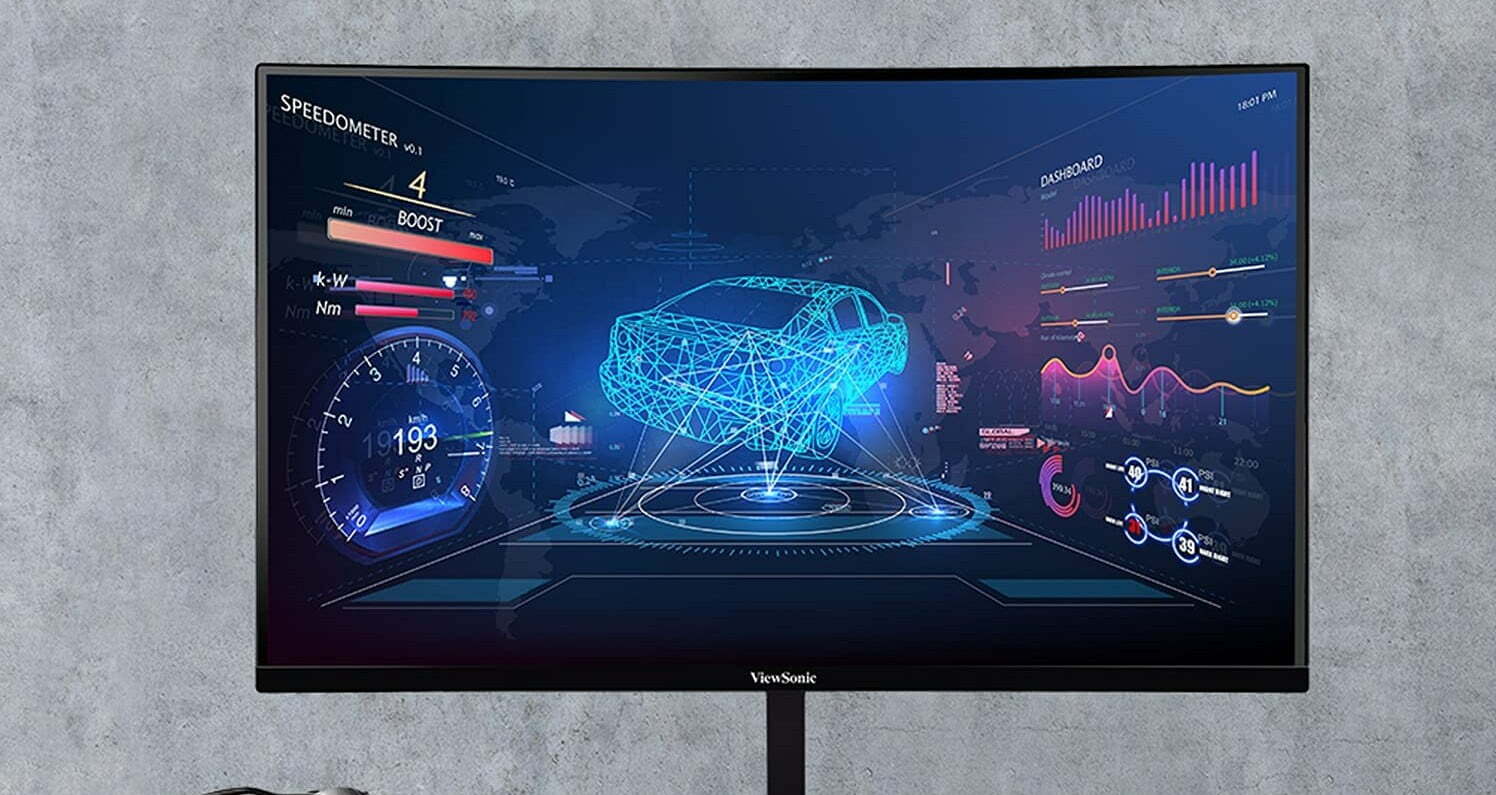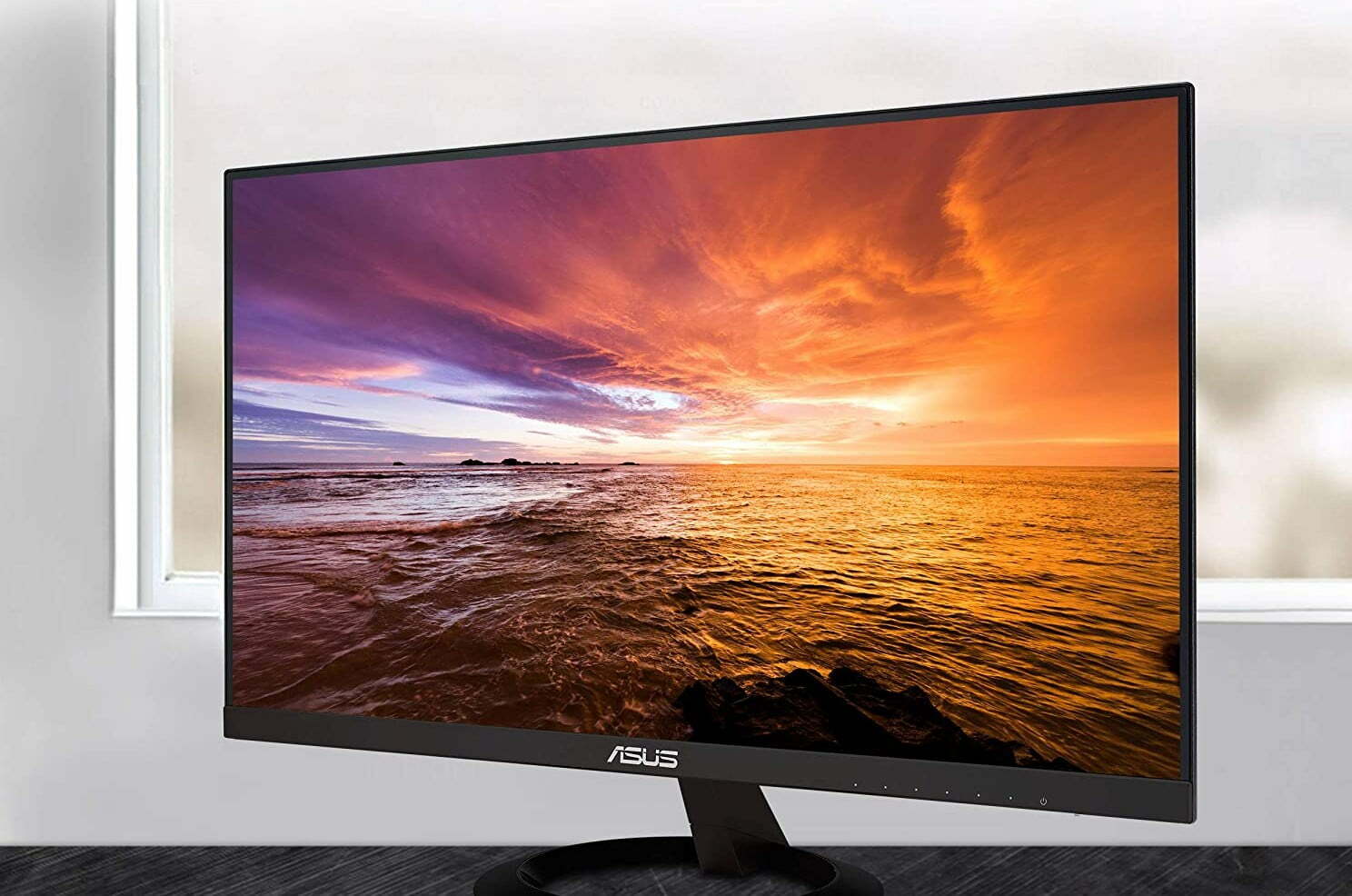Eye strain is the most common physical issue that afflicts regular computer users and can lead to permanent vision damage. The brightness of a display is the biggest factor determining the comfort level and vision safety of the users, whether they’re on a laptop or a desktop PC, and specifically is the biggest factor that contributes to chronic eye strain. Below, we’ll show you how to adjust brightness on your monitor for maximum comfort and safety even for long work sessions.
KEY TAKEAWAYS:
- Brightness should be adjusted according to a room’s light levels
- Correctly adjusting brightness can significantly reduce eye strain
- Regular eye strain can lead to permanent vision damage
We’ll run through your general options for native monitor controls, though they can vary considerably from model to model.
Insider Tip
A display that is bright enough compared to a room’s light to constitute its own light source is too bright.
Eye Strain, Brightness, and Workspace Lighting
Eye strain is the most common issue facing people who spend long hours in front of displays, regardless of the work they’re doing, and while other monitor settings such as contrast, gamma, hue, and vibrancy can play a role in contributing to user eye strain, brightness is the single biggest factor.
Regular excessive eye strain can lead to serious long-term vision issues, in addition to contributing to sleep issues and headaches, so understanding how to properly set monitor and display brightness is a crucial part of setting up a healthy, productive workspace, whether it’s in an office, at home, or in a cafe.
Keep in mind that while brightness plays a big role in eye strain, other elements of the display can be adjusted to improve the overall impact. Find out more in our how to change monitor settings article.
Monitor brightness and room light
What many regular computer users, unfortunately, don’t know is that the light levels in your workspace and the brightness settings of your display work in conjunction with each other. A display that is bright enough compared to a room’s light to constitute its own light source is too bright and will greatly increase eye strain. Conversely, a display that’s too dark compared to the lighting of your workspace will also contribute significantly to eye strain.n
The rule of thumb to follow, then, is that the brightness of your display should be set to match the general brightness of your workspace, so that the display is not brighter than the brightest light source in the room, and isn’t significantly darker.
Insider Tip
The rule of thumb to follow, then, is that the brightness of your display should be set to match the general brightness of your workspace.
Default settings and guidelines
All external displays come with native controls that function completely apart from the operating system of your PC or Mac desktop, while on laptops, the display is controlled from the operating system. The options available to you on external display controls can vary considerably from model to model, but the primary settings will always be brightness and contrast.
Generally speaking, default settings on a monitor’s native controls have brightness and contrast both set to 50 (the middle setting). This is often a good place to have it, since many offices have similar light levels, but remember that the brightness of your display should match the lighting of the room- if the monitor itself is bright enough compared to the room’s lighting to constitute its own light source, it’s too bright. Adjust accordingly until the screen’s brightest whites are no brighter than the primary light source in the room. Contrast can then be adjusted to compliment brightness, to ensure that blacks are deep and rich and whites aren’t washed out, and overall so that text is easily readable. If you have windows 10 then you will notice that it is different and you ought to know how to change monitor brightness on windows 10.
Nighttime settings on Mac and PC
Another useful setting that both macOS and Windows have in common is a nighttime setting that further reduces eye strain and sleep issues by removing a certain (adjustable) amount of blue light from the display’s spectrum.
- In Windows, Night Light can be accessed by entering “Night Light” in the search bar (either with a mouse click or by pressing the Windows key). Use the on/off tab for manual function and use the slider to adjust the strength of the setting until it’s both comfortable and not too dim. You can also set it to automatically turn on and off on a specific schedule.
- In macOS, choose the Apple menu and click on System Preferences, then Displays, and you’ll find the Night Shift tab. As in Windows, you can turn it on and off manually, and use the slider below to change the strength (“warmth”) of the setting, or you can set it to automatically go on and off at sunset and sunrise based on your localization, or to specific hours.
While these are useful tools for fine-tuning brightness and hue throughout the day, keep in mind that a display that’s too dim for your workspace will also increase eye strain.
Warning
Eye strain is the most common issue facing people who spend long hours in front of displays
F.A.Q.
Why is screen brightness such an important setting?
When it comes to eye strain and generally optimal display settings for comfort and productivity, brightness is the most impactful setting and should be set before other settings such as contrast and gamma.
Should I use auto-brightness if it’s available as a setting?
Most laptops and some external displays off auto-brightness functions that measure ambient light and adjust screen brightness to match. Though often it’s sufficient for optimal brightness settings, different uses may require different settings (gaming, movies) that auto-brightness won’t adjust for.
Is VDT syndrome a real issue?
VDT refers to Visual Display Terminal Syndrome and is the most widely used of several terms used to describe the chronic physical issues that can result from regular computer display eye strain. These include chronic headaches, permanent or semi-permanent vision issues, and sleep issues. Most of the issues associated with VDT can be greatly diminished or nearly eliminated by proper display calibration- especially brightness- and other ergonomic considerations such as distance from the monitor, viewing angle, viewing height, and seating positions.
Why does my screen dim itself after a while?
Both Windows and macOS have display sleep settings that can help save power (and extend the life of your display) which dim your display after an adjustable period of disk idling or non-use. This can be adjusted or shut off easily in System Preference under Displays for both.
STAT: Excessive blue light exposure in displays is thought some professionals to contribute to VDT, though direct links have not been completely proven. (source)
REFERENCES:
- https://www.eizo.com/library/basics/10_ways_to_address_eye_fatigue/
- https://www.softpedia.com/get/Desktop-Enhancements/Other-Desktop-Enhancements/ScreenBright.shtml
- https://www.makeuseof.com/tag/screen-brightness-windows-10/r
- https://support.microsoft.com/en-us/windows/change-screen-brightness-in-windows-10-3f67a2f2-5c65-ceca-778b-5858fc007041
- https://displaysolutions.samsung.com/pdf/manual/1325/[S29E790C]WebManual-English.pdf



































![Best 27 Inch Computer Monitor in [year] 27 Best 27 Inch Computer Monitor in 2026](https://www.gadgetreview.dev/wp-content/uploads/how-to-buy-the-best-computer-monitor.jpg)
![Best BenQ Monitors in [year] 28 Best BenQ Monitors in 2026](https://www.gadgetreview.dev/wp-content/uploads/best-benq-monitor-image.jpg)
![Best ASUS Monitors in [year] 29 Best ASUS Monitors in 2026](https://www.gadgetreview.dev/wp-content/uploads/best-asus-monitor-image.jpg)
![Best Dell Monitors in [year] 30 Best Dell Monitors in 2026](https://www.gadgetreview.dev/wp-content/uploads/best-dell-monitor-image.jpg)
![Best HP Monitors in [year] 31 Best HP Monitors in 2026](https://www.gadgetreview.dev/wp-content/uploads/best-hp-monitor-image.jpg)
![Best Lenovo Monitors in [year] 32 Best Lenovo Monitors in 2026](https://www.gadgetreview.dev/wp-content/uploads/best-lenovo-monitor-image.jpg)
![Best ViewSonic Monitors in [year] 33 Best ViewSonic Monitors in 2026](https://www.gadgetreview.dev/wp-content/uploads/best-viewsonic-monitor-image.jpg)
![Best Gigabyte Monitors in [year] 34 Best Gigabyte Monitors in 2026](https://www.gadgetreview.dev/wp-content/uploads/best-gigabyte-monitor-image.jpg)
![Best Monitors for PS4 Pro Gaming in [year] 35 Best Monitors for PS4 Pro Gaming in 2026](https://www.gadgetreview.dev/wp-content/uploads/best-monitors-for-ps4-pro-image.jpg)
![Best Monitor for Xbox Series X in [year] 36 Best Monitor for Xbox Series X in 2026](https://www.gadgetreview.dev/wp-content/uploads/best-monitor-for-xbox-series-x-image.jpg)
![Best Acer Monitors in [year] 37 Best Acer Monitors in 2026](https://www.gadgetreview.dev/wp-content/uploads/best-acer-monitor-image.jpg)
![Best MSI Monitors in [year] 38 Best MSI Monitors in 2026](https://www.gadgetreview.dev/wp-content/uploads/best-msi-monitor-image.jpg)
![Best SAMSUNG Monitors in [year] 39 Best SAMSUNG Monitors in 2026](https://www.gadgetreview.dev/wp-content/uploads/best-samsung-monitor-image.jpg)
![Best LG Monitors in [year] 40 Best LG Monitors in 2026](https://www.gadgetreview.dev/wp-content/uploads/best-lg-monitor-image.jpg)
![Best AOC Monitors in [year] 41 Best AOC Monitors in 2026](https://www.gadgetreview.dev/wp-content/uploads/best-aoc-monitor-image.jpg)
![Best Philips Monitors in [year] 42 Best Philips Monitors in 2026](https://www.gadgetreview.dev/wp-content/uploads/best-philips-monitors-image.jpg)
![Best Monitors For PUBG in [year] 43 Best Monitors For PUBG in 2026](https://www.gadgetreview.dev/wp-content/uploads/best-monitor-for-pubg-image.jpg)
![Best Stream Decks in [year] 44 Best Stream Decks in 2026](https://www.gadgetreview.dev/wp-content/uploads/best-stream-deck-image.jpg)
![Best Monitors for Streaming in [year] 45 Best Monitors for Streaming in 2026](https://www.gadgetreview.dev/wp-content/uploads/best-monitor-for-streaming-image.jpg)
![Best Monitors For Flight Simulator in [year] 46 Best Monitors For Flight Simulator in 2026](https://www.gadgetreview.dev/wp-content/uploads/best-monitor-for-flight-simulator-image.jpg)




















